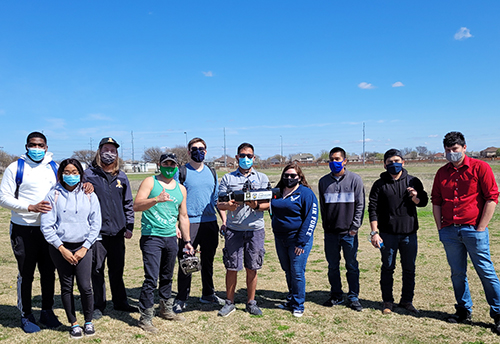A core group of UNT Engineering researchers are rethinking the way Unmanned Aerial Vehicles (UAV) operate as part of an initiative to improve battlefield efficiency and soldier safety for the U.S. Army.
Kamesh Namuduri, professor in the Department of Electrical Engineering, and Assistant Professor Hector Siller in the Department of Mechanical Engineering and University Regents Professor Nandika D’Souza in the Departments of Materials Science and Engineering and Mechanical Engineering have developed a lightweight drone using specially designed materials and additive manufacturing with a goal of improving the UAV’s ability to fly farther and carry more payload, such as increased sensors, supplies or munitions for military units.
 The team is just three of nearly 10 faculty members who make up the multidisciplinary and holistic systems approach for redesigning UAVs to be lighter, stronger, faster and more reliable – an initiative that is front and center for the U.S. Army Combat Capabilities Development Command, known as DEVCOM, Army Research Laboratory.
The team is just three of nearly 10 faculty members who make up the multidisciplinary and holistic systems approach for redesigning UAVs to be lighter, stronger, faster and more reliable – an initiative that is front and center for the U.S. Army Combat Capabilities Development Command, known as DEVCOM, Army Research Laboratory.
“Here at UNT, our expertise is far-reaching. We have experts in tribology, in lightweight materials and additive manufacturing, in wireless communications and in low power electronics and sensors,” said D’Souza. “We have a very strong knowledge-base here and an even stronger community built around collaborative problem-solving. Everything we do here at the College of Engineering is geared toward making a positive, solutions-based impact.”
Collaborating with research group of Dr. Rajneesh Singh (DEVCOM, ARL), UNT faculty and students are currently researching ways to incorporate sensors, vehicle-to-vehicle wireless communication for in-air collision avoidance, 5G broadband data in-flight transmission of visual and radar data, and building wing-morphing structures to make it possible for the UAV to adjust its speed, collect and transmit data, or turn its sensors on and off, as needed. The sensors would also make it possible for the vehicle to more accurately detect its distance from the ground and from other vehicles and collect weather or reconnaissance data and report back in real-time, streamlining critical decision-making for flights and missions.
“This research collaboration has also been great for our students and faculty mentors as it creates a cross-disciplinary environment that is very rewarding for everyone involved. Students gain the opportunity to do real-world research, and faculty are able to complement the theoretical knowledge from the classroom with practical work,” said Siller.
Namuduri also is exploring ways to integrate vehicle health management, using state-of-the-art technology that would enable the UAV to provide real-time health information of the aircraft.
“Our ultimate goal is to make our soldiers safer and better equipped to win on the battlefield. By redesigning and modernizing the functionality of UAVs, the Army would be able to better prepare for any threat or scenario on the battlefield,” said D’Souza. “Ultimately, this would effectively help make our soldiers, and America, safer.”
